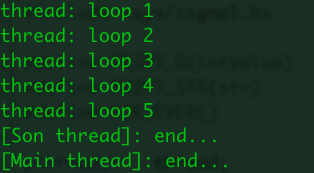[Mac-10.7.1 Lion Intel-based x64 gcc4.2.1]
Q: c标准中包含线程操作么?
A:没有。
Q:给个mac下线程操作的例子吧。
A:创建线程的函数可以实用pthread_create,原型如下:
int pthread_create(pthread_t *restrict thread,
const pthread_attr_t *restrict attr,
void *(*start_routine)(void *),
void *restrict arg);thread是保存成功创建线程的ID; attr表示线程的相关属性,start_routine表示线程执行的函数, arg表示线程执行的使用的参数。
示例代码(保存为testForC.c):
#include <stdio.h>
#include <string.h>
#include <unistd.h>
#include <pthread.h>
#define PRINT_D(intValue) printf(#intValue" is %d\n", (intValue));
#define PRINT_STR(str) printf(#str" is %s\n", (str));
void *thread_one_func(void *args)
{
int i = 1;
while (i > 0)
{
printf("thread: loop %d\n", i++);
}
return NULL;
}
int main()
{
pthread_t thread;
int ret;
ret = pthread_create(&thread, NULL, thread_one_func, NULL);
if(ret < 0)
{
perror("pthread_create error");
return -1;
}
return 0;
}运行:

可以看到,程序运行后然后很快就结束了,且没有任何输出。这是因为主线程过快结束导致结束了刚刚创建的子线程。
Q:如何让主线程不理解结束呢?
A:可以让主线程进入等待状态,加入while(1)循环让主线程一直等待。
#include <stdio.h>
#include <string.h>
#include <unistd.h>
#include <pthread.h>
#define PRINT_D(intValue) printf(#intValue" is %d\n", (intValue));
#define PRINT_STR(str) printf(#str" is %s\n", (str));
#define FOR_EVER() { while(1) ; }
void *thread_one_func(void *args)
{
int i = 1;
while (i > 0)
{
printf("thread: loop %d\n", i++);
}
return NULL;
}
int main()
{
pthread_t thread;
int ret;
ret = pthread_create(&thread, NULL, thread_one_func, NULL);
if(ret < 0)
{
perror("pthread_create error");
return -1;
}
FOR_EVER();
return 0;
}运行结果:

上面是在子线程输出字符串的过程中截取的,子线程会一直运行下去,知道自己的循环退出。
Q:子线程运行的这么快,让它慢点行不?
A:在子线程的while循环中加个延迟1秒的函数,如下:
#include <stdio.h>
#include <string.h>
#include <unistd.h>
#include <pthread.h>
#define PRINT_D(intValue) printf(#intValue" is %d\n", (intValue));
#define PRINT_STR(str) printf(#str" is %s\n", (str));
#define FOR_EVER() { while(1) ; }
void *thread_one_func(void *args)
{
int i = 1;
while (i > 0)
{
printf("thread: loop %d\n", i++);
sleep(1); // sleep for 1 second
}
return NULL;
}
int main()
{
pthread_t thread;
int ret;
ret = pthread_create(&thread, NULL, thread_one_func, NULL);
if(ret < 0)
{
perror("pthread_create error");
return -1;
}
FOR_EVER();
return 0;
}
运行结果:

从实际运行可以看出,子线程每打印一行会延迟一下。
Q:主线程如何在规定的时间内干掉子线程?
A:主线程可以启动定时器,在指定时间内干掉子线程。
int setitimer(int which, const struct itimerval *restrict value, struct itimerval *restrict ovalue);
参数which表示定时器类型,value表示定时器时间信息,ovalue可以设置为NULL.
#include <stdio.h>
#include <string.h>
#include <unistd.h>
#include <pthread.h>
#include <sys/time.h>
#include <sys/signal.h>
#define PRINT_D(intValue) printf(#intValue" is %d\n", (intValue));
#define PRINT_STR(str) printf(#str" is %s\n", (str));
#define FOR_EVER() { while(1) ; }
pthread_t thread;
int should_loop = 1;
void kill_son_thread(int arg)
{
printf("now it will kill son thread...\n");
pthread_cancel(thread);
should_loop = 0;
}
void *thread_one_func(void *args)
{
int i = 1;
while (i > 0)
{
printf("thread: loop %d\n", i++);
sleep(1); // sleep for 1 second
}
return NULL;
}
int main()
{
int ret;
struct itimerval timer;
ret = pthread_create(&thread, NULL, thread_one_func, NULL);
if(ret < 0)
{
perror("pthread_create error");
return -1;
}
// set the timer
timer.it_value.tv_sec = 5;
timer.it_value.tv_usec = 0;
timer.it_interval.tv_sec = 5;
timer.it_interval.tv_usec = 0;
signal(SIGALRM, kill_son_thread); // register a signal for timer action
setitimer(ITIMER_REAL, &timer, NULL); // start the timer
while(should_loop)
;
return 0;
}运行结果:

可以看到,主线程大约5秒后干掉了子线程,然后结束了。
Q: pthread_exit不也可以退出线程么?
A:是的。不用定时器,子线程5秒后自动退出,代码如下:
#include <stdio.h>
#include <string.h>
#include <unistd.h>
#include <pthread.h>
#include <sys/time.h>
#include <sys/signal.h>
#define PRINT_D(intValue) printf(#intValue" is %d\n", (intValue));
#define PRINT_STR(str) printf(#str" is %s\n", (str));
#define FOR_EVER() { while(1) ; }
pthread_t thread;
int should_loop = 1;
void *thread_one_func(void *args)
{
int i = 1;
while (i > 0)
{
printf("thread: loop %d\n", i++);
sleep(1); // sleep for 1 second
if(i == 6)
{
should_loop = 0;
printf("[Son thread]: end...\n");
pthread_exit(NULL);
}
}
return NULL;
}
int main()
{
int ret;
ret = pthread_create(&thread, NULL, thread_one_func, NULL);
if(ret < 0)
{
perror("pthread_create error");
return -1;
}
while(should_loop)
;
printf("[Main thread]: end...\n");
return 0;
}运行结果:

Q:还有个函数,pthread_join的作用是什么?
A:它的作用是等待指定线程执行结束。它实现了线程之间的同步。
#include <stdio.h>
#include <string.h>
#include <unistd.h>
#include <pthread.h>
#include <sys/time.h>
#include <sys/signal.h>
#define PRINT_D(intValue) printf(#intValue" is %d\n", (intValue));
#define PRINT_STR(str) printf(#str" is %s\n", (str));
#define FOR_EVER() { while(1) ; }
pthread_t thread;
int should_loop = 1;
void *thread_one_func(void *args)
{
int i = 1;
while (i > 0)
{
printf("thread: loop %d\n", i++);
sleep(1); // sleep for 1 second
if(i == 6)
{
should_loop = 0;
pthread_exit(NULL);
}
}
return NULL;
}
int main()
{
int ret;
ret = pthread_create(&thread, NULL, thread_one_func, NULL);
if(ret < 0)
{
perror("pthread_create error");
return -1;
}
pthread_join(thread, NULL); // wait for the son thread's end
printf("[Son thread]: end...\n");
while(should_loop)
;
printf("[Main thread]: end...\n");
return 0;
}运行结果:

Q:上面的情形,主线程需要等待子线程结束,如果主线程不必等待子线程结束,子线程为主线程提供必要的数据,二者同步运行,如何处理?
A:那么,可以使用互斥体、信号量等。
#include <stdio.h>
#include <string.h>
#include <unistd.h>
#include <pthread.h>
#include <sys/time.h>
#include <sys/signal.h>
#define PRINT_D(intValue) printf(#intValue" is %d\n", (intValue));
#define PRINT_STR(str) printf(#str" is %s\n", (str));
#define FOR_EVER() { while(1) ; }
pthread_t thread;
int should_loop = 1;
pthread_mutex_t mutex;
int data[3];
void *thread_one_func(void *args)
{
int i = 1;
while (i > 0)
{
pthread_mutex_lock(&mutex);
data[0] = i;
data[1] = i + 1;
data[2] = i + 2;
++i;
sleep(1);
pthread_mutex_unlock(&mutex);
}
return NULL;
}
int main()
{
int ret;
// create and init a mutex
pthread_mutex_init(&mutex, NULL);
ret = pthread_create(&thread, NULL, thread_one_func, NULL);
if(ret < 0)
{
perror("pthread_create error");
return -1;
}
while(1)
{
pthread_mutex_lock(&mutex);
if(data[0] > 3)
{
pthread_mutex_unlock(&mutex);
break;
}
printf("[Main thread]: %d %d %d\n", data[0], data[1], data[2]);
pthread_mutex_unlock(&mutex);
}
pthread_mutex_destroy(&mutex);
printf("[Main thread]: end...\n");
return 0;
}上面的代码,主线程从全局数据data中读取数据,子线程大约每1秒更新下data中的数据,当data[0]的值大于3的时候主线程退出。
运行结果:

Q:还有种类型pthread_cond_t,它和pthread_mutex_t有什么区别?
A:前者是在某种情况下设定的"互斥体",后者可以当成无条件的互斥体;例子如下,
#include <stdio.h>
#include <string.h>
#include <unistd.h>
#include <pthread.h>
#include <sys/time.h>
#include <sys/signal.h>
#define PRINT_D(intValue) printf(#intValue" is %d\n", (intValue));
#define PRINT_STR(str) printf(#str" is %s\n", (str));
#define FOR_EVER() { while(1) ; }
pthread_t thread;
int should_loop = 1;
pthread_mutex_t mutex;
int data[3];
pthread_cond_t cond;
void *thread_one_func(void *args)
{
int i = 1;
while (i > 0)
{
pthread_mutex_lock(&mutex);
data[0] = i;
data[1] = i + 1;
data[2] = i + 2;
if(data[0] % 2 == 0)
pthread_cond_signal(&cond);
++i;
sleep(1);
pthread_mutex_unlock(&mutex);
}
return NULL;
}
int main()
{
int ret;
// create and init a mutex
pthread_mutex_init(&mutex, NULL);
pthread_cond_init(&cond, NULL);
ret = pthread_create(&thread, NULL, thread_one_func, NULL);
if(ret < 0)
{
perror("pthread_create error");
return -1;
}
while(1)
{
pthread_mutex_lock(&mutex);
if(data[0] > 6)
{
pthread_mutex_unlock(&mutex);
break;
}
pthread_cond_wait(&cond, &mutex);
printf("[Main thread]: %d %d %d\n", data[0], data[1], data[2]);
pthread_mutex_unlock(&mutex);
}
pthread_cond_destroy(&cond);
pthread_mutex_destroy(&mutex);
printf("[Main thread]: end...\n");
return 0;
}上面的代码,主线程当发现data[0]大于6时就退出;小于6的时候,等待cond的状态变化;子线程会更新data数组中的数值,且当data[0]是偶数的时候就激活等待cond的线程(主线程),二者实现同步和互斥。
运行效果:

对于同步互斥,semaphore也可以实现; sem_open, sem_wait等等是操作它的函数,这里不再一一介绍。
xichen
2012-5-19 15:46:26
分享到:


















相关推荐
c语言多进程多线程编程
c语言多线程c语言多线程
C语言的开始设计,并未设计多线程的机制,由于随着软硬件的发展及需求的发展。后来C语言才开发了线程库以支持多线程的操作、应用。 主要基于Linux介绍C多线程。在编译C的多线程时候,一方面必须指定Linux C语言...
统中才引入多线程机制,如今,由于自身的许多优点,多线程编程已经得到了广泛的应用。 本文我们将介绍在Linux 下编写多进程和多线程程序的一些初步知识。 1 引言 对于没有接触过 Unix/Linux 操作系统的人来说,fork ...
C语言使用多线程例子,使用createthread这个windows--api函数来生成多线程。
windows下c语言中多线程实现,vs2015编译
c语言多线程编程.pdf
基于c语言的多线程程序,运行环境是VC++6.0 ,dos界面的控制台应用程序。代码简单有注解,亲测保证可以运行。
C语言多线程编程,包括多线程的创建,调用,销毁,还有接口等等
linux c语言 多线程 网页爬虫 spider
C语言的多线程包Posix的API参考chm格式
c语言__多进程和多线程
线程如何去创建 ,多线程如何控制输出!互斥控制!
对Linux下C语言编程--线程操作作了详细的说明
Linux下多线程计算圆周率 C语言 //实现一个用多线程计算 π(圆周率)的程序。 #include #include #include #include #define N 50000//设定计算次数 #define NUM 2//设定线程数,经过反复实验,在装有1个双核...
本程序利用C语言实现多线程ping程序,运行效果较好
c语言-编译预处理指令#pragma omp-支持多线程Multiple Threads 你不用启动多线程,该指令帮你把程序变为多线程执行,还可指定只使用几个CPU而不使用所有CPU
进程是一个具有独立功能的程序关于某个数据集合的一次而可以并发执行的运行活动,是处于活动状态的计算机程序...再操作系统设计上,从进程演化出线程,最主要的目的就是更好的支持多处理器系统和减小上下文件切换开销。
C语言多线程编程实例.pdf